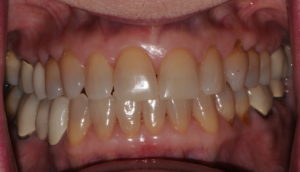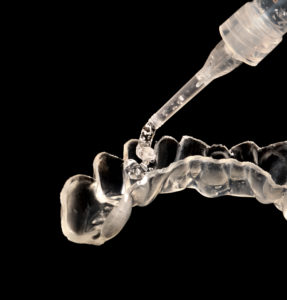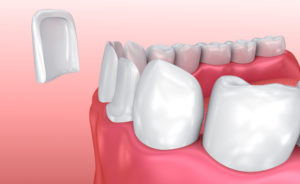How Can I Treat Deep Stains on My Teeth?
Almost everyone today wants a brighter, whiter smile. For those with deep staining, this can be difficult to achieve. There are a few different ways to approach deep, dark stains on the teeth. They produce varying degrees of results and carry different pros and cons.
What Causes Deep Stains on the Teeth?
There are different types of staining of teeth, and the different type does affect which treatments will be effective. Stains can build up on the outer surface of teeth, which we call extrinsic staining. Stains may also be incorporated into the body of the teeth as they form, referred to as intrinsic staining.
There is some discussion, and not yet a consensus, among dental professionals about whether extrinsic staining can penetrate the enamel and become intrinsic staining over time. The truth is that we do not need to have the answer to that question before we treat the teeth in the ways described below.
Extrinsic Staining
 Almost everyone will accumulate extrinsic staining on the teeth over time. This results from dark colored pigments in food, drinks, and tobacco products. The darker the substance and the more frequently you use it, the more stains you will accumulate. Most external staining will respond to techniques of polishing the outermost layer of enamel. This happens when you use whitening toothpaste, which contains small abrasive particles, and when you undergo a professional teeth cleaning.
Almost everyone will accumulate extrinsic staining on the teeth over time. This results from dark colored pigments in food, drinks, and tobacco products. The darker the substance and the more frequently you use it, the more stains you will accumulate. Most external staining will respond to techniques of polishing the outermost layer of enamel. This happens when you use whitening toothpaste, which contains small abrasive particles, and when you undergo a professional teeth cleaning.
Polishing away external stains is a great way to maintain a white smile after teeth whitening, especially if you intend to keep drinking those 4 cups of coffee a day….
Intrinsic Staining

Because intrinsic staining exists below the outer layer of enamel, it will not respond to polishing with whitening toothpastes and professional teeth cleanings. It will, however, respond to teeth whitening products containing hydrogen peroxide or one of its close relatives. Because peroxide compounds penetrate the enamel to break down dark pigmented molecules within the tooth, they do work on intrinsic staining.
Stains that form during tooth development, like those associated with the drug Tetracycline and a condition called fluorosis, are the deepest and most difficult to treat.
What are the Options to Treat Deep Stains?
There are multiple options available for improving your smile by whitening or covering deep stains that you don’t like on your teeth.
Over-the-Counter Whitening Products
The first place for many people to begin is by using over-the-counter teeth whiteners. These products can make a noticeable difference in many cases. In general, the cost is very inexpensive, the application method is frustrating, and the results are minimal.
Because they are inexpensive, they can be a good tool to help you and your dentist understand which teeth whitening will help you achieve your goals. For example, if you noticed a small, but noticeable, result from using a 10-day regimen of Crest Whitestrips, this tells your dentist that your teeth do respond to the peroxide chemical in teeth whitening gels. Then we can expect a greater result with a higher-powered gel applied by a dental professional.
Pros:
- Inexpensive
- Some results expected
Cons:
- Difficult to maintain on the teeth due to sub-optimal application methods
- Minimal results
- Time consuming
- No guarantee of results
- Requires maintenance of whitening
Professional Teeth Whitening
 When considering professional teeth whitening, we include any type of whitening that requires a dental visit. At Designer Smiles, this includes in-office whitening and professional take-home teeth whitening. Both use high strength professional whitening gels and precise application to the teeth.
When considering professional teeth whitening, we include any type of whitening that requires a dental visit. At Designer Smiles, this includes in-office whitening and professional take-home teeth whitening. Both use high strength professional whitening gels and precise application to the teeth.
In cases of deep staining, professional teeth whitening is more effective than over-the-counter products. However, you can expect it to take longer to remove deep stains than it does to just generally brighten the overall appearance of the teeth. Some case studies show improvement of deep tetracycline staining by consistently whitening with high powered gel in custom-fitted trays for six months.
Pros:
- Greater effectiveness at deep stains than over-the-counter products
- Faster results
- Easier method of application with custom-fitted trays
Cons:
- More expensive than OTC teeth whitening products
- Time consuming
- Requires maintenance of whitening
Porcelain Veneers
 Porcelain veneers do not fall under the category of teeth whitening. However, they are an effective treatment for teeth with deep stains. Typically, porcelain veneers are not the first treatment option of choice when the complaint is staining. However, when patients have attempted whitening with no success, porcelain veneers may be the final treatment to help them reach their smile goals.
Porcelain veneers do not fall under the category of teeth whitening. However, they are an effective treatment for teeth with deep stains. Typically, porcelain veneers are not the first treatment option of choice when the complaint is staining. However, when patients have attempted whitening with no success, porcelain veneers may be the final treatment to help them reach their smile goals.
A veneer effectively whitens teeth by replacing the outer layer of enamel with porcelain, which can be any color the patient chooses. (We have yet to see any patients choose something besides white . . .). By covering the visible surfaces of teeth, porcelain veneers cover any unsightly defects or staining. We often refer to this as “permanent teeth whitening”. Porcelain is a highly-glazed glass, which resists stain and maintains its appearance for decades.
Veneers carry the added benefit of changing not only the color of the teeth; they can change the shape, size and alignment, too.
Pros:
- Guaranteed to cover any type of staining
- No whitening maintenance required
- Capable of treating other cosmetic problems in addition to stains, like misshapen, chipped, or misaligned teeth
Cons:
- Requires dental treatment
- Expensive (up to $1500 per tooth)
- May require protective nightguard during sleep
More Questions about Treating Deep Stains in Your Teeth?
Call Designer Smiles today and schedule a consultation with Dr. Ann and Dr. Lauren. They can answer any questions you have about your specific staining and what options will work best to help you achieve your smile goals.
